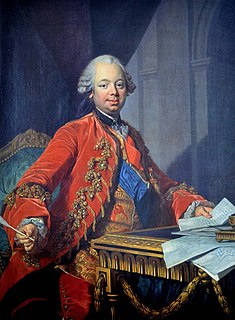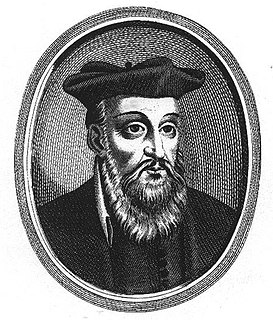
Claude Lorrain was a French painter, draughtsman and etcher of the Baroque era. He spent most of his life in Italy, and is one of the earliest important artists, apart from his contemporaries in Dutch Golden Age painting, to concentrate on landscape painting. His landscapes are usually turned into the more prestigious genre of history paintings by the addition of a few small figures, typically representing a scene from the Bible or classical mythology.

Étienne François, Marquis de Stainville, Duc de Choiseul, KOHS, OGF was a French military officer, diplomat and statesman. From 1758 and 1761 and from 1766 and 1770, he was Foreign Minister of France and had a strong influence on France's global strategy throughout the period. He is closely associated with France's defeat in the Seven Years' War and subsequent efforts to rebuild French prestige.

François-Louis Français (1814–1897), also known as Louis Français, was a French painter, lithographer and illustrator who had a long and successful commercial career. A former pupil of Gigoux, he began his career by studying lithography and wood engraving, becoming a prolific illustrator and print-maker. His work as an illustrator is to be found in around forty books and numerous magazines from the late 1830s to the 1860s. Français also produced a large number of pen and ink drawings, enhanced by sepia, notable for their attention to detail and for their technical adroitness and conciseness.

The Church of St. Louis of the French is a Roman Catholic church in Rome, not far from Piazza Navona. The church is dedicated to the Virgin Mary, to St. Denis the Areopagite and St. Louis IX, king of France. The church was designed by Giacomo della Porta and built by Domenico Fontana between 1518 and 1589, and completed through the personal intervention of Catherine de' Medici, who donated to it some property in the area. It is the national church in Rome of France. It is a titular church. The current Cardinal-Priest of the title is André Vingt-Trois, Archbishop of Paris.

Jean-Baptiste Jacques Augustin was a French miniature painter.

Pierre Le Muet was a French architect, military engineer, and writer, famous for his book Manière de bâtir pour toutes sortes de personnes, and for the châteaux he constructed, most notably Tanlay in Burgundy, as well as some modest houses in Paris, the grandest of which, the Hôtel d'Avaux (1644–1650) survives and has recently been restored to a semblance of its seventeenth-century condition.

Jean-Michel Moreau, also called Moreau le Jeune, was a French draughtsman, illustrator and engraver.
Events from the year 1682 in art.

Jean-François Bosio (1764–1827) was a French artist, born in Monaco. He spent some time in Milan, where he used the name Giovanni Battista Bosio.

Robert Le Lorrain (1666–1743) was a French baroque sculptor who was born in Paris. He was born into a family of bureaucrats, the son of Claude Le Lorrain, a business agent of Nicolas Fouquet, Louis XIV's Minister of Finance. Le Lorrain was a student of the French sculptor, painter, and architect, Pierre Paul Puget (1620-1694). At age eighteen, Le Lorrain entered François Girardon's studio; aside from collaborating with him, he was commissioned to instruct Girardon's children in drawing and to supervise his other pupils. Le Lorrain won the Prix de Rome in 1689, On his return to Paris he first joined the Académie de Saint-Luc, and then was received into the Académie royale de peinture et de sculpture in 1701; he became Rector of the Académie in 1737. His major non-royal clients were members of the house of Rohan. His students included Jean-Baptiste Lemoyne (1704-1778) and Jean-Baptiste Pigalle (1714-1785). Robert Le Lorrain died in Paris in 1743.

Francesco Manno was an Italian painter and architect. Born at Palermo in 1754, he was originally a goldsmith, but later devoted himself to painting. In 1786 he settled at Rome, working in the studio of Francesco Preziado de la Vega. Manno became the Secretary of the Accademia di San Luca. On 13 July 1794 he became a member of the Accademia dei Virtuosi del Pantheon. Favored by Pope Pius VI, Manno was appointed Painter of the Sacred Apostolic Buildings in 1800. He died in Rome in 1831.

Jean Boulanger, a French line-engraver, son of the painter Olivier Boulanger and cousin to the painter of the same name, was born at Amiens in 1608 and baptized in Troyes in Champagne on 24 January 1608; he had five children with Marie Judon. He was documented in Paris in 1645 and resided in the parish of Saint-Etienne-du-Mont.

Pierre-Charles Canot (c.1710–77) was a French engraver who spent most of his career in England.
Jean-François Cars, was a French engraver, printer, publisher and printseller from Lyon.

Louis-Jacques Cathelin (1738–1804) was a French engraver.
Henry Madin was a French composer at the Chapelle royale.

Charles-Michel-Ange Challe, born in Paris on February 13, 1718 and died January 8, 1778 is a painter, draftsman and French architect.

Jacques-Nicolas Tardieu, called "Tardieu fils" or "Tardieu the younger", was a French engraver.

Claude Ambroise Régnier, Duke of Massa, was a French lawyer and politician. He was a deputy in 1789, a member of the Council of Ancients, a member of the Senate and a Minister.
Christophe Annedouche was a French engraver from Paris. He is known for his natural history illustrations in works such as Georges Cuvier's Le Règne Animal.
















